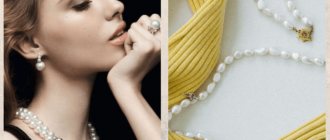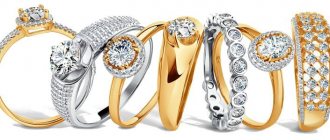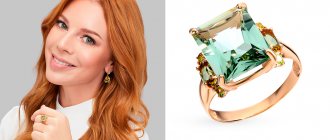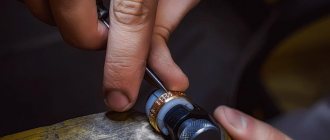The word “brooch” comes from the French “broche”, which means “long needle”. This name is explained by the original purpose of the brooch - to fasten clothes. And the need to fasten clothes appeared when a person first put on something larger than a loincloth. Therefore, it is not surprising that the history of the brooch is almost equal to the history of mankind.
Brooches and agraphs are the most ancient types of brooches
The first analogue of a brooch appeared more than 5 thousand years ago in the Bronze Age. It not only differed from the modern brooch in its design, but also had a different name - fibula . The fibula was made of metal and most often was a circle with two holes through which a massive curved pin was passed, holding the fabric together. But it quickly spoiled the fabric, and soon people came up with a safe design for a fibula with a spike-shaped pin. The fibula had many design varieties. For example, the Hungarian fibula was made of solid metal wire and its design resembled a traditional safety pin. And the Greek fibula consisted of two or four spiral circles connected together. At the same time, the needle came out of one spiral and was fixed on the other.
Examples of antique brooches - brooches:
agraffes appeared - hairpins that were used to fasten the collar of an undershirt or simply put on as decoration. Later they began to be used as hair clips. During the Renaissance, due to a radical change in fashion, brooches and agraphs lost their positions because they were no longer needed, and pendants came into fashion.
Examples of antique brooches - agraph:
Stylist tips:
• The more intricate and unique the design of your brooch, the more you will stand out.
• Make sure the fabric can support the weight of the brooch.
• Brooches and pins are more noticeable if they contrast with the background.
• Bright colored brooches are best suited for black and dark fabrics. Brooches made of silver and with rhinestones are also recommended for black or dark-colored clothing; if you really want your brooch to stand out in the latest fashion, remember this simple rule.
• Experiment with old brooches and find new and unusual ways to wear them.
• Collect several brooches of the same theme or style.
• Remember proportions! An elegant brooch is more suitable for a graceful figure (only if you do not need to create an extravagant image). For large figures, choose more massive jewelry or a scattering of small ones.
Look at the photo to see fashionable brooches for 2022. You can get a whole range of design ideas:
The Sevigne brooch is the ancestor of modern types of brooches
In its current understanding, the brooch appears only in the 17th century thanks to the French writer and favorite of King Louis XIII, Madame de Sevigne . It was she who introduced the brooch as an accessory into fashion. Madame de Sevigne found that tying ribbons or sewing pendants to dresses was a job that took too much time. And she came up with the first brooch in the form of a bow with a pendant attached to it . Such a brooch could easily be fastened to the right place on the dress. Madame de Sevigne's brooch caused a real boom among French fashionistas, and every lady of high society considered it a matter of honor to have several different brooches in her arsenal (more about Baroque jewelry). The popularity of this accessory is also explained by the fact that court ladies began to use brooches to convey “secret” information. Having put on the agreed brooch, the lady, for example, informed a certain person that she could receive a secret guest, or that she had received important news.
Portraits of Madame Sevigne wearing brooches of her invention:
So, with the light hand of Madame de Sevigne, this wonderful accessory came into fashion and remains popular to this day.
Golden rules
Oscar de la Renta, Fashion operandi
As we all know, fashion rules are made to be broken, so these recommendations are just food for thought. You can't go wrong with them, but always leave room for maneuver. Who knows, suddenly, having broken absolutely all the rules from this list, you will be able to create a masterfully harmonious image. So!
1. The brooch should be the main highlight of the look. Regardless of whether you pin it on a blouse or the lapel of a coat, excess can be disastrous - large earrings, flashy bracelets, a heavy necklace will most likely compete with the brooch.
2. A brooch always draws attention to the area where it is located, so you should carefully consider where you will pin it.
3. Special chic - if the brooch matches your bag or shoes. This could be color consistency or similar graphic elements.
4. Several brooches at once are an excellent solution, but a precious vintage brooch will not appreciate being next to cheap jewelry.
What types of jewelry brooches are there?
There are several criteria by which types of brooches are distinguished.
Depending on the material of manufacture , brooches are distinguished:
- Jewelry brooches made of precious metals . They can be either with or without inserts. Inserts are made of precious or semi-precious stones, pearls, and enamel.
- Jewelry brooches made of brass or other alloys. Such brooches are encrusted with semiprecious stones, rhinestones, glass beads or Swarovski crystals.
- Brooches made from other materials - polymer clay, plastic, leather, beads, wood, textiles, felted wool. These jewelry are often made by hand (brooches using the handmade technique), which gives them a special charm.
Brooches are also distinguished by the type of decorative treatment and are divided into the following types:
Openwork brooches , the material for which is metal, bone, plastic and others. Metal openwork brooches are made by cutting out the openwork or stamping, as well as using the filigree technique. Brooches made of bone, plastic or other ornamental materials are made by carving openwork patterns.
Smooth brooches . Smooth brooches mainly consist of one large ornamental stone, for example, landscape or landscape agate. Often, many small pebbles are also placed around the stone to shade it.
Brooches-gems - made in the form of reliefs on stones. Gems with bas-reliefs (that is, a convex, protruding image) are called “cameos”. On the contrary, gem brooches with a “high-relief”, recessed image were called “intaglios” . Such decorations were highly valued not only as jewelry (often made from valuable stones or shells), but even more as works of art - miniatures with various subjects, portraits and genre scenes.
Cameo brooches are an eternal classic of jewelry art . This is an image made on an oval-shaped precious or semi-precious stone using the bas-relief technique with carefully carved details. The bas-relief of a cameo is usually light - white, milky, ivory, beige, and the oval base is dark, usually black, blue, brown or red. The most common subject for a cameo is the delicate profile of a woman’s head with clear edges of her hair, neck and face. But cameos also depict portraits of famous personalities, angels, small scenes from ancient mythology, everyday scenes, flowers. Today cameos are made from different materials, but traditionally they were made from agate, jasper, onyx, and various quartz. The cameo oval was set with precious metal and decorated with pearls and precious stones. Empress Catherine II was a great lover of cameos, who called her love for these decorations “stone disease.” It was because of the empress’s great love for cameos that mass development of precious and semi-precious stones from the Ural Mountains began.
Intaglio brooches This is also a type of gem, and the opposite of a cameo, since the image is made using the technique of in-depth (negative) relief. Intaglios are carved on precious or semi-precious stones or glass. Oval intaglios are also often framed with metal and decorated with stones or pearls.
Enamel brooches . The bases of such brooches are made of gold, silver, copper, and less often brass. Enamel is applied to the base. They use different application techniques - painted enamel , reproducing various designs (for example, the famous Rostov enamel), cloisonné enamel (clausan technique), champlevé enamel (the so-called champlevé technique). Enamel brooches are often finely crafted artistic miniatures that complement the perimeter jewelry (read more about hot and cold enamel jewelry).
Mosaic brooches . They are usually made from smalt , a specially melted glass that comes in a wide variety of colors. The mosaic is made up of small pieces of smalt, which, according to the composition, are glued into the base of the brooch using a special mastic. The surface of the mosaic is polished. This technique is called micromosaic.
Some other varieties of this accessory are also highlighted:
- brooches-clips for shawls, scarves and stoles
- handmade brooches using soutache, kanzashi, boho and other techniques
- wedding brooches on the dress or in the bride's hair, boutonnieres for bridesmaids, brooches-bouquets of the bride
- boutonniere for the groom
Brooches are also divided by type of fastening :
Brooch pin . Recently, this type of brooch is especially popular. As the name implies, it is a pin on which various additions are strung. You can string many different stones, pendants and chains onto such a brooch, which will make you feel like a designer.
Brooch-clip . It is attached like a clip to the edge of clothing. This brooch is also used as a hair clip.
Brooch-needle (pin - from the English pin) , which is attached using a special safe needle.
Where to buy beautiful brooches
JEWELIRUMA catalog - an updated selection of interesting jewelry brands with search filters | Where to buy designer jewelry - review of sites | Seven brands of premium jewelry presented in Russia | The main exhibitions and sales of jewelry and designer costume jewelry
TYPES OF JEWELRY | JEWELRY - BROOCHES
Fashion brooches | How to wear a brooch. Brooches on a dress. Brooches for shirts and blouses | Chanel brooches and Tiffany brooches
Men's brooches. Brooches for collar and tie | Handmade techniques for making brooches. Brooches in boho style. Tatting brooches. Brooches in kanzashi and komono style. Beaded and felted brooches | Brooch for a scarf. Brooch for stole. How to tie a scarf with a brooch? | How to attach a boutonniere to a jacket? | Brooch for a wedding dress | Hair brooches
Share this article with your friends
Works by designers from the JEWELIRUM catalog
- Co.Cos Jewelry
- Co.Cos Jewelry
- Taiga Jewelry, Tomsk
- Taiga Jewelry, Tomsk
- Ilya Maksimov, Crimea
- Ilya Maksimov, Crimea
- UBIRING
- UBIRING
- Diamonds are Forever
- Diamonds are Forever
- Rings in natural style, Sergacheva Jewelery
- Earrings with pearls, Sergacheva Jewelery
- Cabochon ring, Minty Sky
- Fly earrings, Minty Sky
- Ring, Precious Park
- Ring, Precious Park
- Snake skin ring, Stoyanova Jewelery
- Chain earrings, Stoyanova Jewelery
- Children's pendant - stick, Matthew&Daniel
- Pendant for a child, Matthew&Daniel
- Bracelet, Svetlana Subbotina
- Ring with Slavic symbols, Svetlana Subbotina
- Indian style ring, Anna Goffman
- Indian style ring, Anna Goffman
- Earrings, ISTA
- Geometric ring, ISTA
- Earrings with enamel, PNJewelry
- Ring with enamel, PNJewelry
- Ring, Khramtsova Jewelry
- Ring, Khramtsova Jewelry
- Wedding rings to order, obruchalki.com
- Wedding rings to order, obruchalki.com
- Earrings, Yuri Bylkov
- Earrings, Yuri Bylkov
- Titanium bracelets, LanaMuransky
- Titanium pendant, LanaMuransky
- Brooch Elephant (after Salvador Dali), THING
- Ring Veil, THING
- Mace earrings, VLADIMIR MARKIN
- Cufflinks, jewelry mechanics, VLADIMIR MARKIN
- Drop-shaped ring, EKATERINA TOLSTAYA
- Drop-shaped earrings, EKATERINA TOLSTAYA
- Necklace with amber, LETA
- Earrings with amber, LETA
- Children's earrings, combinable, FASHBY
- Children's earrings, combinable, FASHBY
- Ring of architectural form, Elizaveta Malafeevskaya MANU_L
- Architectural bracelet, Elizaveta Malafeevskaya MANU_L
- Set Ginkgo Leaf, SHABUT JEWELLERY
- Brooch Wearable porcelain, SHABUT JEWELLERY
- Architectural ring, GEOMETRY
- Brooch, porcelain, GEOMETRY
- Necklace made of polymer clay, LICORNE ART
- Brooch made of polymer clay, LICORNE ART
- Ring, avant-garde, VALERY SEREDIN
- Bracelet, avant-garde. VALERY SEREDIN
- Wooden set, Scandinavian/Japanese minimalism, VLADIMIR SHESTAKOV
- Ring, Scandinavian/Japanese minimalism, VLADIMIR SHESTAKOV
- Earrings, TON ANT
- Ring, TON ANT
- Architectural ring, ANCHOR
- Architectural necklace, ANCHOR
- Earrings, GOHFELD JEWELLERY
- Necklace, GOHFELD JEWELLERY
- Massive ring, YAKISCHIK
- Designer jewelry, YAKISCHIK
- Architectural ring, ONE DAY ART
- Architectural ring, ONE DAY ART
- Brooch, bionics, VALERIYA MARKOVA (TESSA)
- Unclosed ring, bionics, VALERIYA MARKOVA (TESSA)
- Ring, bionics, BEAVERS
- Earrings, bionics, BEAVERS
- Earrings, asymmetry, VAGANOVA JEWELRY
- Airplane ring, VAGANOVA JEWELRY
- Flower ring, ALCHEMIA JEWELLERY
- Set, ALCHEMIA JEWELLERY
- Pendant-cat, ethnic, STUDIO OF ILYA AND VERA PALKIN
- Earrings, STUDIO OF ILYA AND VERA PALKIN











